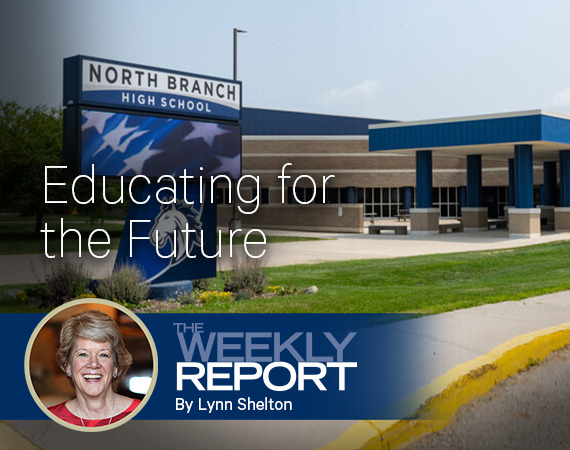
Educating for the Future
The Weekly Report – May 28, 2024
The principal at North Branch Area High School uses education to connect high school students with career opportunities that will drive the future of manufacturing.
There’s an exciting shift happening in high school education, and Clint Link, the focus of the next “Four Questions” feature in Enterprise Minnesota® magazine, is at the leading edge of it.
We first met Link at the regional rollout of Enterprise Minnesota’s 2023 State of Manufacturing® survey in North Branch when he discussed the proactive role of public education in the future of Minnesota manufacturing. He impressed us with his understanding of the labor needs of manufacturing and his dedication to preparing his students for those promising careers.
When Link took over as principal of North Branch Area High School in 2022, he brought a wealth of experience in public education and a commitment to giving students a foundation that allows them to thrive in their community after graduation. Link began as a social studies teacher, and saw how Chromebooks allowed more independent learning, especially for kids with different backgrounds and skill sets. “I eventually left the classroom to teach teachers how to leverage technology to personalize education,” he says.
He later moved into career pathways as career and technical education evolved. High schools moved away from career tech ed in the late ’90s because reading and math standardized tests — and later science — were being pushed on schools, Link explains. “We put our resources into those spaces, but labor markets were looking for students with skilled-based understanding,” he says.
When he arrived in North Branch as a principal, he found a growing district that shared his vision for preparing students for careers in industry. “We have the facilities and the postsecondary partners to execute it. I think we are what the modern high school should be.”
For Link and the North Branch region, that means giving students the opportunity to pursue technical careers and a head start on the education needed for those jobs. “Parents understand that most kids don’t need a four-year postsecondary path. I worked in Waseca for 20 years of my career,” he says. “Sixty percent of jobs in that region required a certification or a two-year degree. Only 20% of those jobs required a four-year degree, but we still had 80% of our graduates going to four-year institutions.”
Link wants to help students avoid going into debt for an education that leaves them under-skilled for the labor market. North Branch partners with Pine Technical and Community College, which has the resources to help kids get higher levels of skill training in areas like industrial, machining, welding, or auto courses.
“These are very expensive courses to run. We have several postsecondary partners like Pine Tech, in our case, that have equipment and teachers,” Link says. “It’s up to us to be creative in how we partner together. Do we share equipment for a duration of time? Do they bring a trailer to our campus so that we can use some equipment for a period of time? Do we do tours? Can kids work at night up there?”
Link also relies on area employers to boost career and technical education programs at the school. The Perkins V Federal Grant for Career and Technical Education helps supplement associated expenses and requires the school to have an advisory board composed of more than 50% industry partners. “Those partners help guide what and how we’re teaching kids and give us a direct partnership in resources,” he says.
Link’s vision of the future for North Branch students involves two big ideas. First, is a concept called “Choice, not Chance” that urges students to consider how everyday choices influence the future. “Once high school kids understand how things they do now will impact their future — and how those things are within their control — then it’s up to me and our staff to provide them with relevant opportunities,” he says.
The second is what Link calls the “Big Blur,” which blends the high school setting and post-secondary classes with work-based learning, which he envisions scaling up in the next five years. “More kids taking college-level courses in career and technical education and more kids leaving school during the day to do internships, externships, or apprenticeships,” he says. “So, when they leave high school, they feel confident about whatever education choices they need to make to start their professional career faster.”
Read the full interview with Clint Link in the Summer 2024 issue of Enterprise Minnesota® magazine.
 Upcoming Events
Upcoming Events
Find manufacturing workshops and events on our events page.
 Industry News
Industry News
Second round of layoffs announced at St. Peter boat manufacturer, 106 employees impacted
May 25, Bring Me The News
Made in Mountain Iron: An inside look at Spring Creek Manufacturing
May 24, WDIO.com
Kern Laser Systems receives Minneapolis/St. Paul Business Journal manufacturing award
May 23, Wadena Pioneer Journal
Minnesota Becomes 5th State to Approve Extended Producer Responsibility (EPR) Packaging Law
May 22, Packaging World
SICK celebrates groundbreaking of $64 million expansion in Bloomington, Minnesota
May 22, Modern Materials Handling

